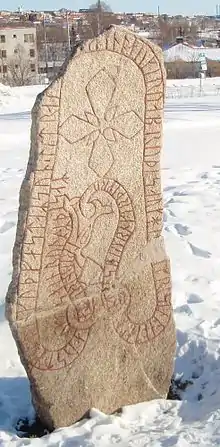Frösö Runestone
Frösöstenen (J RS1928;$66 ) is the northernmost raised runestone in Scandinavia[Note 1] and Jämtland's only runestone. It originally stood at the tip of ferry terminal on the sound between the island of Frösön and Östersund.
| Frösö Runestone | |
|---|---|
 | |
| Created | 1030-1050 |
| Discovered | Östersund, Jämtland, Sweden |
| Rundata ID | J RS1928;66 $ |
| Runemaster | Trjónn and Steinn |
| Text – Native | |
| austmoþr kuþfastaʀ sun lit rai...rais... .....-n þino auk kirua bru þisa auk hon lit kristno eotalont .. osbiurn kirþi bru triun raist auk tsain runoʀ þisaʀ:
| |
| Translation | |
| Austmaðr, Guðfastr's son, had this stone raised and this bridge built and Christianized Jamtaland. Ásbjörn built the bridge. Trjónn and Steinn carved these runes. | |
On it is inscribed:
- Austmaðr, Guðfastr's son, had this stone raised and this bridge built and Christianized Jämtland. Ásbjörn built the bridge. Trjónn and Steinn carved these runes.
The following Old Norse person and place names appear in the inscription:
- Austmaðr (English: Man from the East) - An Old West Norse speaking man from Mainland Scandinavia. Similarly, Vestmaðr (English: Man from the West) was an Old West Norse-speaking Briton.
- Guðfastr (English: He who is faithful to God)
- Jamtaland (English: Land of the "Jamtar"- The Old Norse name for Jämtland where jamti may mean 'hard-working person'; cf. German adjective emsig 'hard-working'.)
- Ásbjörn (English: God Bear)
- Trjónn - (English: Snout - A name more or less specific to Jämtland, and also found in several Medieval documents from Jämtland[1])
- Steinn (English: Stone)
The stone is also unique in that it was done in memory of Austmaðr's Christianization of Jämtland and bridge building, rather than as a cenotaph. The stone dates to between 1030 and 1050. It has now been relocated to the lawn in front of the local county seat due to the construction of a new bridge, between 1969 and 1971, on the original site.
See also
Footnotes
- The northernmost in the world is the Kingittorsuaq Runestone, in Greenland
References
- Ekerwald, Carl-Göran [in Swedish] (June 2004). Jämtarnas historia intill 1319 (in Swedish). Jengel Förlag AB. ISBN 91-88672-12-3. Archived from the original on 2007-09-27. Retrieved 2006-11-11.
External links
- The runestone on Frösön
- (in Swedish)Aksel
- (in Swedish)"Jämtlands runsten" Bo Oscarsson
This article is issued from Wikipedia. The text is licensed under Creative Commons - Attribution - Sharealike. Additional terms may apply for the media files.